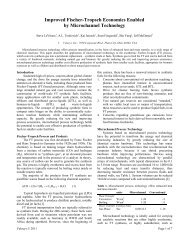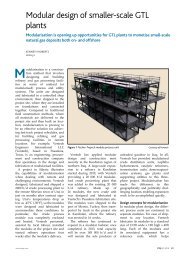Oxford Catalysts Group PLC Annual Report and Accounts 2010
Oxford Catalysts Group PLC Annual Report and Accounts 2010
Oxford Catalysts Group PLC Annual Report and Accounts 2010
You also want an ePaper? Increase the reach of your titles
YUMPU automatically turns print PDFs into web optimized ePapers that Google loves.
<strong>Oxford</strong> <strong>Catalysts</strong><strong>Group</strong> <strong>PLC</strong><strong>Annual</strong> <strong>Report</strong><strong>and</strong> <strong>Accounts</strong><strong>2010</strong>The <strong>Group</strong> leases certain property, plant <strong>and</strong> equipment. Leases of property, plant <strong>and</strong> equipment where the <strong>Group</strong> hassubstantially all the risks <strong>and</strong> rewards of ownership are classified as finance leases. Finance leases are capitalised at thelease’s commencement at the lower of the fair value of the leased property <strong>and</strong> the present value of the minimum leasepayments.Each lease payment is allocated between the liability <strong>and</strong> finance charges so as to achieve a constant rate on the financebalance outst<strong>and</strong>ing. The corresponding rental obligations, net of finance charges, are included in other long-termpayables. The interest element of the finance cost is charged to the income statement over the lease period so as toproduce a constant periodic rate of interest on the remaining balance of the liability for each period. The property, plant<strong>and</strong> equipment acquired under finance leases is depreciated over the shorter of the useful life of the asset <strong>and</strong> the leaseterm.Revenue RecognitionRevenue is measured at the fair value of the consideration received or receivable <strong>and</strong> represents amounts receivable forgoods <strong>and</strong> services provided in the normal course of business, net of trade discounts, value added tax <strong>and</strong> other salesrelated taxes <strong>and</strong> after eliminating sales within the <strong>Group</strong>.Revenue from development contracts is measured in accordance with the <strong>Group</strong>’s policy on development contracts.Revenue on most development contracts is earned on a time <strong>and</strong> materials, supplemented by milestones, basis <strong>and</strong> isrecognised as the work is performed. In the situation where contracts are for fixed services <strong>and</strong> value, where the outcomeof a development contract can be estimated reliably, revenue <strong>and</strong> costs are recognised by reference to the stage ofcompletion of the contract activity at the balance sheet date. This is normally measured by the proportion that costsincurred for work performed to date bear to the estimated total costs, except where this would not be representative of thestage of completion.Where the outcome of a development contract cannot be estimated reliably, contract revenue is recognised to the extent ofcontract costs incurred where it is probable that they will be recoverable. Contract expenses are recognised as costs in theperiod in which they are incurred. When it is probable that total contract costs will exceed revenue, the total expected lossis recognised as an expense immediately.Contracts for development work may include either upfront payments or milestone payments, payable on successfulattainment of defined milestones. Where upfront non-refundable payments are received on signing of an agreement, suchpayments are deferred <strong>and</strong> amortised over the life of the agreement to which it relates. For milestone payments, revenueis only recognised when the milestone has been successfully achieved <strong>and</strong> no further obligations remain.Revenue is recognised only when the collection of related receivables is probable. When uncertainty arises about thecollectability of an amount that has already been recorded in revenue, any provision required as a result of that uncertaintyis recognised as an expense <strong>and</strong> not a reduction in revenue.Grants are recognised as income over the periods necessary to match them, on a systematic basis, with the costs whichthey are intended to compensate. Grant income is not recognised until the conditions for their receipt have been compliedwith <strong>and</strong> there is reasonable assurance that the grant will be received. In the event that a grant appears to have to berepaid, provision is made for the estimated liability.Where a grant is received to fund the acquisition of property, plant <strong>and</strong> equipment, the income is deferred <strong>and</strong> recognisedover the useful economic life of the related asset.Interest income is accrued on a time basis by reference to the principal outst<strong>and</strong>ing <strong>and</strong> at the effective interest rateapplicable.Intangible AssetsLicencesLicences are capitalised at the present value of the minimum licence payments. Amortisation will commence when relatedrevenue starts to be earned <strong>and</strong> it will be charged in equal annual instalments over the life of the patents to which thelicences relate. Provision is made for any impairment.29











